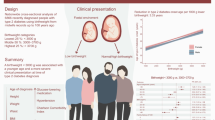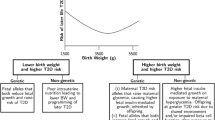Abstract
Recent findings have sparked intense interest in birth weight as a predictor of type 2 diabetes mellitus. In some populations, there is an inverse association between birth size and disease; however, in the Pima Indians, a population with very high rates of gestational diabetes, high birth weight and low birth weight are associated with diabetes. This results in a U-shaped curve with higher diabetes rates in both tails of the distribution. Similarly, there are reports of an inverse association between stature and prevalence of gestational diabetes, but, in California Latina women with gestational diabetes, there is a positive association between stature and glucose concentration. Could these disparate findings also represent the two ends of a U-shaped curve? The disparities are likely due to differences in the environment, both in utero and postnatally, that different groups experience.
Similar content being viewed by others
References and Recommended Reading
Hales CN, Barker DJP: Type 2 (non-insulin-dependent) diabetes mellitus: the thrifty phenotype hypothesis. Diabetologia 1992, 35:595–601.
Hales CN: Fetal nutrition and adult diabetes. Sci Am Sci Med 1994, July/August:54–63.
McCance DR, Pettitt DJ, Hanson RL, et al.: Birth weight and non-insulin-dependent diabetes: thrifty genotype, thrifty phenotype, or surviving small baby genotype? BMJ 1994, 398:942–945.
Valdez R, Athens MA, Thompson GH, et al.: Birthweight and adult health outcomes in a biethnic population in the USA. Diabetologia 1994, 37:624–631.
Lithell HO, McKeigue PM, Berglund L, et al.: Relation of size at birth to non-insulin dependent diabetes and insulin concentrations in men aged 50-60 years. BMJ 1996, 312:406–410.
Clausen JO, Borch-Johnsen K, Pedersen O: Relation between birth weight and the insulin sensitivity index in a population sample of 331 young, healthy Caucasians. Am J Epidemiol 1997, 146:23–31.
Barker DJP, Bull AR, Osmond C, Simmonds SJ: Fetal and placental size and risk of hypertension in adult life. BMJ 1990, 301:259–262.
Barker DJP, Godfrey KM, Fall C, et al.: Relation of birth weight and childhood respiratory infection to adult lung function and death from chronic obstructive airways disease. BMJ 1991, 303:671–675.
Barker DJP, Hales CN, Fall CHD, et al.: Type 2 (non-insulindependent) diabetes mellitus, hypertension and hyperlipidaemia (syndrome X): relation to reduced fetal growth. Diabetologia 1993, 36:62–67.
Joseph KS, Kramer MS: Review of the evidence on fetal and early childhood antecedents of adult chronic disease. Epidemiol Rev 1996, 18:158–174.
Leon DA, Koupilova I, Lithell HO, et al.: Failure to realize growth potential in utero and adult obesity in relation to blood pressure in 50 year old Swedish men. BMJ 1996, 312:401–406.
Stanner SA, Bulmer K, Andres C, et al.: Does malnutrition in utero determine diabetes and coronary heart disease in adulthood? Results from the Leningrad siege study, a cross sectional study. BMJ 1997, 315:1342–1348.
Dahri S, Snoeck A, Reusens-Billen B, et al.: Islet function in offspring of mothers on low-protein diet during gestation. Diabetes 1991, 40:115–120.
Hoet JJ: Influence of dietary changes on the development of the fetal pancreas—consequences later in life. Isr J Med Sci 1991, 27:423–424.
Anastasiou E, Alevizaki M, Grigorakis SJ, et al.: Decreased stature in gestational diabetes mellitus. Diabetologia 1998, 41:997–1001.
Jang HC, Min HK, Lee HK, et al.: Short stature in Korean women: a contribution to the multifactorial predisposition to gestational diabetes mellitus. Diabetologia 1998, 41:778–783.
Branchtein L, Schmidt MI, Matos MCG, et al.: Short stature and gestational diabetes in Brazil. Diabetologia 2000, 43:848–851.
Kousta E, Lawrence NJ, Penna A, et al.: Women with a history of gestational diabetes of European and South Asian origin are shorter than women with normal glucose tolerance in pregnancy. Diabet Med 2000, 17:792–797.
Persson I, Ahlsson F, Ewald U, et al.: Influence of perinatal factors on the onset of puberty in boys and girls: implications for interpretation of link with risk of long term diseases. Am J Epidemiol 1999, 150:747–755.
Neel JV: Diabetes mellitus, a thrifty genotype rendered detrimental by ‘progress’? Am J Hum Genet 1962, 14:353–362.
Vanlandingham MJ, Buehler JW, Hogue CJR, Strauss LT: Birthweight-specific infant mortality for Native Americans compared with Whites, six states, 1980. Am J Public Health 1988, 78:499–503.
Alo CJ, Howe HL, Nelson MR: Birth-weight-specific infant mortality risk and leading causes of death: Illinois, 1980-1989. Am J Dis Child 1993, 147:1085–1089.
Rees JM, Lederman SA, Kiely JL: Birth weight associated with lowest neonatal mortality: infants of adolescent and adult mothers. Pediatrics 1996, 98:1161–1166.
Barker DJP, Osmond C: Infant mortality, childhood nutrition, and ischaemic heart disease in England and Wales. Lancet 1986, 1:1077–1081.
Knowler WC, Pettitt DJ, Saad MF, Bennett PH: Diabetes mellitus in the Pima Indians: incidence, risk factors and pathogenesis. Diabetes Metab Rev 1990, 6:1–27.
Pettitt DJ, Aleck KA, Baird HR, et al.: Congenital susceptibility to NIDDM: role of the intrauterine environment. Diabetes 1988, 37:622–628.
Dabelea D, Hanson RL, Lindsay RS, et al.: Intrauterine exposure to diabetes conveys risks for type 2 diabetes and obesity: a study of discordant sibships. Diabetes 2000, 49:2208–2211.
Dabelea D, Pettitt DJ, Hanson RL, et al.: Birth weight, type 2 diabetes, and insulin resistance in Pima Indian children and young adults. Diabetes Care 1999, 22:944–950.
Pettitt DJ, Knowler WC: Long-term effects of the intrauterine environment, birth weight, and breast-feeding in Pima Indians. Diabetes Care 1998, 21:B138-B141. This study demonstrates the U-shaped curve during pregnancy. McCance et al. [3], using a longitudinal population study of diabetes and its risk factors in Pima Indians, were the first to describe a U-shaped association between birth weight and adult disease. Previous studies had identified an inverse association, making it appear that the larger the baby the better off it would be in terms of adult diseases.
Jovanovic L, Ilic S, Noyyen M, Pettitt DJ: Short stature in Latina women with gestational diabetes mellitus (GDM) is not associated with higher glucose. Diabetes 2000, 49(suppl 1):A443-A444.
Metzger BE, Coustan DR: Summary and recommendations of the Fourth International Workshop-Conference on Gestational Diabetes Mellitus. Diabetes Care 1988, 21 (suppl 2):B161-B167.
Author information
Authors and Affiliations
Rights and permissions
About this article
Cite this article
Pettitt, D.J., Jovanovic, L. Birth weight as a predictor of type 2 diabetes mellitus: The U-shaped curve. Curr Diab Rep 1, 78–81 (2001). https://doi.org/10.1007/s11892-001-0014-x
Issue Date:
DOI: https://doi.org/10.1007/s11892-001-0014-x




